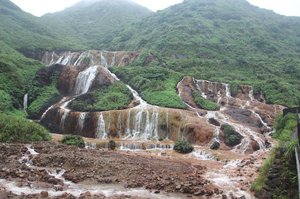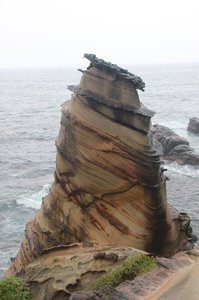North Coast
Yehliu Park
Yeliou is a cape of about 1.7km long formed
by the Datun Mountain reaching into the sea.
When overlooked from above, the place is
like a giant turtle submerging into the sea.
Thus, it is also called ‘Yeliou Turtle’.
Because the rock layer of seashore contains
sandstone of limestone texture and it is
subject to sea erosion, weathering and earth
movements, there are many stone formations.
The park is divided into three sections.
The first section has rocks with shapes identified
as Queen's Head, Fairy's Shoe and
the Candle. The second section has rocks
known as Bean Curd and Dragon Head. The third
section has sea-eroded caves, seal shaped
rock, etc. In addition, there is a statue
of Lin Tien Jane in commemoration of the
person's bravery of sacrificing his own
life for saving others. There is also a marine
world which has about 200 rare fish species
and marine animals
|
|
|
|
|
|
|
|
|
|
|
|
|
|
|
|
|
|
|
|
|
|
|
|
|
|
|
|
|
|
|
|
|
|
|
|
|
|
|
|
|
|
|
|
|
|
|
|
|
|
|
|
|
|
|
|
|
|
|
|
|
|
|
|
|
|
|
|
|
|
|
|
|
|
|
|
|
|
|
|
|
|
|
|
|
|
|
|
|
|
|
|
|
|
|
|
|
|
|
|
|
|
|
|
|
|
|
|
|
|
|
|
|
|
|
|
|
Jiufen village (Jioufen / Chuifin)
Jiufen is famous for its old mining town
charming characteristics. It is said that
long time ago there were only nine families
in Jiufen. Before the roads were built, all
materials were transported via ships. Thus
a tradition was formed that nine pieces of
the same object were purchased at one time.
Hence, the name of Jioufen.
Jiufen is located within the hills in northeast
of Taiwan. The village is next to the mountain
and facing the sea. In 1890, someone struck
gold near Jiufen. The poor village with only
nine families soon attracted prospectors
of 4,000 families. The village was once known
as the gold city of Asia and called little
Shanghai or little Hong Kong. However, with
the decline of gold mining activities, Jiufen
faded. Later, several movies were shot there..
The prosperous old streets, buildings, mines
and the glamorous gold digging days are long
gone and now it promotes its many unique
teahouses. The most prosperous shopping district
is Jinshan Street that goes through most
of the village, with its many shops vending
the most famous country snack of Geo Fan,
yam dish and various local dishes as well
as many preserved historical items.
|
|
|
|
|
|
|
|
|
|
|
|
|
|
|
|
|
|
|
|
|
|
|
|
|
|
|
|
|
|
|
|
|
|
|
|
|
|
|
|
|
|
|
|
|
|
|
|
|
|
|
|
|
|
|
|
|
|
|
|
|
|
|
|
|
|
|
|
|
|
|
|
|
|
|
|
|
|
Gold Ecological Park, Jinguashi
The site of the mine was used as an allied
prisoner-of-war camp from 1942. The original
buildings in the park are well preserved
with Japanese style buildings, light vehicle
way, gold museum, gold temple, gold furnace,
old post office, police office, residences
of "Mige Kiku Zirou" and Crown
Prince Chalet, etc. The Crown Prince's
Chalet is in Japanese Style with a Fuji Mountain
window. The attention in the detail of this
building shows the privileged status of the
owner at the time. Weaving among the architectures
in the park is the BenShan Wu Keng Ancient
Trail. The Gold museum houses the world largest
pure 99.9% gold brick, weighing 220kg.
|
|
|
|
|
|
|
|
|
|
|
|
|
|
|
|
|
|
|
|
|
|
|
|
|
|
|
|
|
|
|
|
|
|
|
|
|
|
|

Gold Waterfall
Due to the mining history, the underground
water sprouted out and became a striking
waterfall. The waterfall's direction
and sound changes according to the rain fall.
When the rain water mixes with Iron and Carrollite,
it oxidized and catalyzed by bacteria within
iron and becomes yellowish-orange acidic
water
Yin Yang Hai, (Bay of Two colours)
The sea has two colours -a brownish/yellowish
colour due to the copper and iron deposits
amidst a majestic blue. Some believe that
the yellowish sea colour was due to the pollution
resulting from smelting activities of the
mining company. Strangely, even though the
mining company has stopped operating, the
Yin-yang sea still exists. Scholars claim
that it is a natural phenomenon rather than
a man-made pollution as the area has a large
amount of pyrite that has formed Fe3+ which
does not dissolve easily in water. This results
in the formation of iron ion floating particles
when it flows into the sea. The colour of
the sea varies depending on the weather and
season.

Nanya Rock
The northernmost area, Nanya is noted for
its fantastic rock formations and sea-eroded
coral shore. The entire coastline here is
a veritable sculpture garden that illustrates,
in stone, the incomparable artistry of weathering
and wave action. The patterned stone topography
of Nanya, unique in Taiwan, was formed through
the weathering of the sandstone that lines
the shore. The oxidation of iron ore within
the striations of the stone has given it
a beautiful striped pattern
Bitou Cape
From afar, Bitou Cape looks like the nose
of a kitten leaning by the sea. The total
area of the cape is about 4 to 5 km2, whose
tall abrasion caves and platforms and other
eroded landforms are clearly in sight on
the cape's hanging cliff. With an elevation
of about 120m, the Bitou Cape Lighthouse
is at the end of the trail along which there
are endless scenes from the ocean and eroded
landforms. Standing in the lighthouse, waves
from the East China Sea and the Pacific meet
right in front of you.
Keelung City, Harbour & night market
Keelung City is Taiwan’s seventh largest
city and it is also the largest natural port
in northern Taiwan. The east, west, and south
side of the city are all surrounded by mountains
with a small plain area in the north side
reaching out to the Pacific Ocean. Serving
as a natural harbour, Keelung bay reaches
deeply into downtown deeply. Within the city
are many more slopes than planes and with
the Keelung Islet and Hoping Islet protecting
Keeling on both sides of the water it is
strategically difficult to invade the town.
Chung Cheng Park (previously Kang Park), situated on the
side of Ta Sha Wan Shan is home to the 25m
white statue of Goddess of Mercy which is
the biggest Goddess statue in Southeast Asia.
Inside is a stairway leading to the top with
views over Keeling harbour.
The famous snacks and desserts in the Keelung
Miaokou Night Market are: Tempura, Oyster
Omelet, Shrimp Thick Soup, Bean-Sprout Thick
Soup, Healthy Sandwich, Bubble Ice, Dingbiancuo,
etc. Also, the famous cuisines such as steamed
butter crabs with butter, eel thick soup,
and pork knuckles are on the Aisi Road. Keelung’s
Bisa Harbor is a famous tourist fish market.
There are over twenty seafood restaurants
near the harbour offering fresh seafood cuisine.
Visitors may also purchase fresh seafood
in the fish market and bring it to a nearby
seafood restaurant and ask them to serve
it. The most famous snack in Keelung is the
pineapple cake.